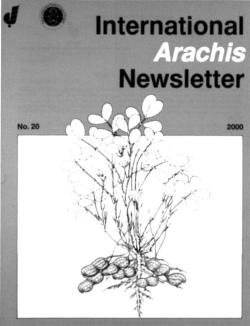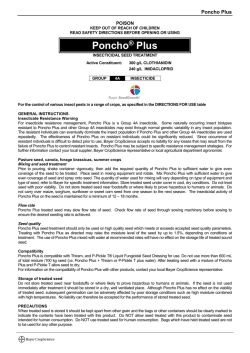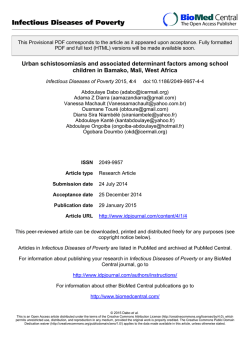
in Niger - Academic Journals
Vol. 10(5), pp. 334-344, 29 January, 2015 DOI: 10.5897/AJAR2013.8364 Article Number: 5FC08DB49849 ISSN 1991-637X Copyright © 2014 Author(s) retain the copyright of this article http://www.academicjournals.org/AJAR African Journal of Agricultural Research Full Length Research Paper Evaluation of agro-morphological diversity of groundnut (Arachis hypogaea L.) in Niger Nana Mariama IDI GARBA1, Yacoubou BAKASSO1, Mainassara ZAMAN-ALLAH2, Sanoussi ATTA3*, Maârouhi Inoussa MAMANE1, Moutari ADAMOU4, Falalou HAMIDOU5, Saïdou Sani IDI1, Ali MAHAMANE1 and Mahamane SAADOU1 1 Laboratoire Garba Mounkaila, Département de Biologie, Faculté des Sciences et Techniques, Université Abdou Moumouni, BP 10662 Niamey, Niger. 2 Université de Maradi, BP 465 Maradi, Niger. 3 Centre Régional AGRHYMET, BP 11011 Niamey, Niger. 4 Institut National de la Recherche Agronomique du Niger, BP 429 Niamey, Niger. 5 International Crops Research Institute for the Semi-Arid Tropics (ICRISAT), BP 12404 Niamey, Niger. Received 10 December, 2013; Accepted 9 January, 2015 This work evaluated a collection of hundred groundnut (Arachis hypogaea L.) varieties from different origin using twenty four (24) agro-morphological traits that can help to enhance selection efficiency in crop improvement. The experiment was carried out at the experimental station of INRAN-Tarna, in the region of Maradi (Niger) during the rainy season of 2010. Analysis of variance showed a large variability among varieties for the agro-morphological traits. Principal Component Analysis (PCA), Agglomerative Hierarchical Clustering (AHC) and Fisher Discriminant Analysis (FDA) revealed that this variability is structured into four distinct groups. Groups I and II consisted of early varieties that have a high emergence rate and high pods and seed weight. These groups included mainly local varieties and those introduced in Niger through seed dissemination. Groups III and IV are composed of late varieties with large pods while group III had mostly varieties with long leaflets. Understanding the genetic control of the most discriminating among the studied traits would bring significant contribution to the genetic improvement of this important crop. Key words: Arachis hypogaea L, groundnut, agro-morphological traits, genetic variability, Niger. INTRODUCTION Groundnut (Arachis hypogaea L.) is an important grain legume that grows in wet conditions in semi-arid regions of the world (Rao, 1980). As major crop in most of the tropical and subtropical regions, groundnut ranks 12th in the world crop production. It is grown in all continents with a total area of 24.6 million hectares, and a production of 41.3 million tons in 2012 (FAO, 2013). Africa, with 11.7 million hectares of land used for groundnut production and 10.9 million tons of annual production in 2012 is second only to the American *Corresponding author. E-mail: [email protected]. Author(s) agree that this article remain permanently open access under the terms of the Creative Commons Attribution License 4.0 International License Garba et al. continent (FAO, 2013). Despite this second position in terms of groundnut production, Africa has the lowest average yield per hectare (1 ton ha-1) compared to Asia (1.8 tons ha-1) and America (3 tons ha-1). These low yields are related not only to the rainfed production systems combined with very low input but also to the use of traditional varieties that despite their genetic diversity are low yielding. Several studies have shown that there is a large agromorphological diversity in groundnut. This large diversity has led to the distinction of two sub-species: A. hypogaea subsp. hypogaea and A. hypogaea subsp. fastigiata. These subspecies are distinguished primarily by their port, usually crawling in hypogaea and erected in fastigiata, the absence of flowers on the main axis in hypogaea and the difference in leaf color: Dark green in hypogaea and light green in fastigiata (Fonceka, 2010). Both subspecies were themselves divided into several botanical groups including several commercial types. Groundnut plays a key role in African farming systems, including savanna zone, in rotation or in combination with staple crops. In Niger, groundnut is widely cultivated in the southern belt of the country where its production provides both food for humans and feed for livestock. In addition, it is used as fuel and also contributes to protect the environment through nitrogen fixation. It also provides an additional source of income as a cash crop (NARP, 1993). Globally in 2007, groundnut production volume representing 10% of the production of oilseeds, accounted for a turnover of about $ 17 billion (Foncéka, 2010). Evaluation of genetic resources is a key step towards efficiency in utilization of these resources through introduction of new genes as well as for their maintenance. In addition, the evaluation and characterization of the collection on the basis of morphological and agronomic traits are the starting point of any breeding program (Fundora, 1998; Simpson et al., 1986). There are several reports on breeding for varieties adapted to abiotic and biotic stresses to alleviate the major constraints in groundnut production (Ntare and Waliyar, 2000). However, in Niger, research activities on this topic are still not well articulated (Maria, 2009) although a number of groundnut varieties were released (Ndjeunga et al., 2003). The present study aimed to (i) study the variability of a collection of groundnut varieties collected in Niger through the evaluation of morphological and agronomic traits and (ii) analyze how the diversity of these traits is structured. MATERIALS AND METHODS Plant materiel This study was conducted using groundnut (A. hypogaea L.) from Niger (Table 1). This collection, Moutari from Institut National de a collection of 100 varieties of various origins and cultivated in kindly provided by Dr Adamou la Recherche Agronomique du 335 Niger (INRAN) was evaluated during the rainy season of 2010. Experimental site The trial was carried out at the experimental station of INRAN Tarna, in the region of Maradi which is located in the Sahel sedentary agro-climatic zone (Saadou, 1990), 657 km east of Niamey (13° 27 N and 7° 06 E) and 353 m above sea level (Figure 1). The characteristics of the soil and climate are presented in Table 2. The total rainfall recorded in 2010 was 592.4 mm distributed over 47 days. Experimental design The experimental design was a randomized complete block design with three (3) replications each, separated by 1.5 m. In each block a variety is represented by two rows of 3 m long and separated by an alley of 0.5 m. On each row, the seed were sown in 20 holes separated from each other by 0.15 m. Sowing was done on July 18th, 2010 at the rate of three seeds per hole. Prior to sowing, the seeds were treated with fungicide (Thioral). Two weeks after emergence, the plants were thinned to one plant per hole. Traits measured All the agronomic and morphological traits studied were selected from descriptors in the peanut IBPGR / ICRISAT Manual (1992). The parameters were measured on five plants per variety and per block. Two categories of traits have been studied namely quantitative traits (Table 3) and qualitative traits (Table 4). Data analysis Frequency table was used for qualitative data while a comparison of means by the analysis of variance (ANOVA) was performed for quantitative data. Analysis of the variability structure was done with multivariate analysis (MANOVA). Principal component analysis (PCA) defines the main components to account for the largest fraction of the total variance. Hierarchical clustering (AHC) using the unit Euclidean distance was performed to test for linkage between varieties and the resulting clusters were characterized through Fisher discriminant analysis (FDA) on the basis of the most discriminating traits. RESULTS For each qualitative trait, the frequency of the different morphological types is presented in Figure 2. From all the studied traits, seed color (CGR), leaf color (CFE) and to some extent pod reticulation (RGO) were the least variable as for each of them, there was one predominant morphological type. Grain color was rose for 85% of the varieties, while 62% had light green leaves (CFE) and 67% reticulated pods (RGO). Unlike these three characters which showed a trend towards the predominance of one morphological type, there were two major morphological types for the plant port (PPL) with 47% of varieties belonging to the erected and 45% to the semi-erect type. The traits showing the highest variability 336 Afr. J. Agric. Res. Table 1. Origins of the groundnut varieties. N° 1 2 3 4 5 6 7 8 9 10 11 12 13 14 15 16 17 18 19 20 21 22 23 24 25 26 27 28 29 30 31 32 33 Varieties T 4 - 83 T 5 - 83 T 6 - 83 T 18 - 83 T 19- 83 T 49 - 83 T 79 - 83 T 92 - 83 T 95 - 83 T 108 - 83 T 133 - 83 T 134 - 83 T 145 - 83 T 152 - 83 T 163 - 83 T 169 - 83 T 177 - 83 T 183 - 83 T 45 - 87 T 46 - 87 T 42 - 88 T 44 - 88 T 1 - 89 T 4 - 89 T 13 - 89 T 14 - 89 T 16 - 89 T 20 - 89 T 35 - 89 T39 - 89 T 2 - 93 T 1 - 95 T 2 - 96 Origins Niger Niger Niger Niger Niger Niger Niger Niger Niger Niger Niger Niger Niger Niger Niger Niger Niger Niger Niger Niger Niger Niger Niger Niger Niger Niger Niger Niger Niger Niger Niger Niger Niger N° 35 36 37 38 39 40 41 42 43 44 45 46 47 48 49 50 51 52 53 54 55 56 57 58 59 60 61 62 63 64 65 66 67 Varieties T 1 -2005 T 2 - 2006 T 3 - 2006 T 4 - 2006 T 1 - 2007 T 2 - 2007 Zanzaro Maradi T M - H - 94 KH -241 -D Chico UGA - 7 RRB 796 55 - 33 FDRF 5 - 277 SRV I - 3 CG - 8 - 35 ICG 3736 ICG 3968 ICG 6121 ICG 6760 ICG 7433 ICG 9199 ICG 11183 ICGV 86024 ICGV 86072 ICGV 86124 ICGV 86529 ICGV 87003 ICGV 87281 ICGV 91284 ICGV 91317 ICGV 91341 were (i) pod spout (BGO) with 3 to 4 morphological types: Moderate spout (31%), light spout (30%), without spout (25%) and to a lesser extent the prominent spout (12%); and (ii) pod throttle (EGO): thin throttle type (44%), moderate throttle (34%) and without throttle (17%). ANOVA exhibited highly significant differences (p <0.001) for all traits except for the length of leaflets as indicated by F values (Table 5) and the extent of variation was quite large. For example, the pod weight varied from 32 g (ICGV91317) to 113.5 g (T13-89) and the number of days to flowering varied from 23 (T42-88, T134-83, T583, ICGV 93305 and ICGV 91341 23) to 29 days (Q2 96 ICG6760, T4-83 and ICGV IS 96806). Similarly, the 100seed weight ranged from simple (22.3 g for ICGV IS 96806) to more than double (51 g for ICG3938). Besides, the block effect was highly significant for all traits except Origins Niger Niger Niger Niger Niger Niger Niger Niger Burkina Faso Spain Nigeria Nigeria Russia ICRISAT ICRISAT ICRISAT ICRISAT ICRISAT ICRISAT ICRISAT ICRISAT ICRISAT ICRISAT ICRISAT ICRISAT ICRISAT ICRISAT ICRISAT ICRISAT ICRISAT ICRISAT ICRISAT ICRISAT N° 69 70 71 72 73 74 75 76 77 78 79 80 81 82 83 84 85 86 87 88 89 90 91 92 93 94 95 96 97 98 99 100 Varieties ICGV 93305 ICGV 10973 ICGV- IS-96606 ICGV -IS -96806 ICGV- SM-99506 ICGV-SM-99513 ICG S - 31 TA 94092 Tx AG - 1 Tx 798739 Tx 804472 Tx 855157 Tx 872561 Tx 872616 Tx 872621 Tx 883623 Tx 903020 Tx 903644 Tx 903654 Tx 903714 Tx 903796 Tx 903838 Tx 903839 72 - 112 73 - 30 55 - 437 O - 20 EC - 5 Nelson spanish JL - 24 Fleur 11 Tainan 9 Origins ICRISAT ICRISAT ICRISAT ICRISAT ICRISAT ICRISAT ICRISAT America America America America America America America America America America America America America America America America America America America America America America India India India for the number of branches, the seed width and threshing index. For the interaction between varieties and blocks, the difference was not significant for all traits except for leaf length. Principal component analysis (PCA) revealed that the first four axes account for 51.4% of the variation of the traits measured in the 100 varieties. To define the relationship between the agro morphological traits, the eigenvectors and the correlations between 21 traits out of 24 were analyzed along with the main components. Only characters that are highly correlated with one of the first three components were presented in Table 6. The projection of these characters on the first two principal components (Figure 3) showed that: 1. Axis 1 explains 20.6% of total variation. It combines Garba et al. 337 Location of the region of Maradi Legend Tarna Site (CERRA/Maradi) Figure 1. Experiment site location. Table 2. Soil and weather conditions of the experiment site (INRAN Tarna). Soil Type Acidity Total Nitrogen Organic Carbon Phosphorus CEC Organic matter Sandy loam pH = 6.49 0.07% 0.24% 16.12 ppm 1.94 meq/100g 0.41% Climate Rainfall (mm) RH (%) Temperature (°C) Average rainfall (2000-2009) 400 mm≤ PI<600 mm 18%<HR<77% 18.6°C <T<37.1°C 491.01 mm high values of pod length and width of pods, seed length and days to flowering as opposed to the lowest values of main stem height, harvest index and number of plants after emergence. 2. Axis 2, with 12.6% of the variation is defined by the following characters: Seed width, 100-seed weight, pod weight and seed weight. Varieties at the positive side of axis 2 have small values and those at the negative side of this axis have high values for these traits. These results suggest that late genotypes had larger pods, longer seeds and smaller harvest index. In addition, genotypes with low pod weight, shorter seeds and small 100-seed weight were identified from component 2. The dendrogram resulting from hierarchical clustering (CAH) with 0.8 units of truncation threshold of Euclidean distance exhibited four distinct groups (Figure 4). The number of varieties in the different groups was 22, 66, 3, and 9 for groups I, II, III, and IV, respectively (Table 7). The distribution of varieties in different groups showed that diversity was not structured based on origin. Fisher discriminant analysis (FDA) performed using the data of the four identified groups provided distances 338 Afr. J. Agric. Res. Table 3. Description of the studied quantitative traits. Parameters No of plants Days to flowering Main stem height Haulm dry weight No of branches/plant Plant throttling Harvest index Abbreviations NPL DFL HTP PFS NBR EPL IR Leaflet length LOF Leaflet width LAF No Harvested plants Pod weight Pod length Pod width Threshing index Seed weight 100-Seed weight Seed length Seed width NPR PGO LOG LAG IB PGR PCG LGR WGR Descriptions No of plants per plot 4 weeks after sowing Number of days from sowing to flowering Height in cm from ground level to the terminal bud (average of 5 plants) Dry weight (g) of 5 plants excluding pods Number of cotyledonary lateral branches (average of 5 plants) Length of branches (cm) 2 months after planting (average of 5 plants). % Ratio of seed weight to total dry biomass. Length (cm) of the apical leaflet of the third leaf of the main stem along the limbus (5 leaflets / plant and average of 5 plants). Width (mm) of the apical leaflet of the third leaf of the main stem. Measurements were taken between the tops of the leaflet. (Five leaflets per plant and average of 5 plants). Number of plants just before harvest Weight (g) of pods (average of 5 plants) Length (mm) of mature pod (5 pods / plant and average of 5 plants) Width (mm) of mature pod (5 pods / plant and average of 5 plants) % Ratio of seed weight to pod weight (seed weight / pod weight * 100) Grain weight (g) (average of 5 plants). 100-seed weight (average of 5 plants). Seed length (mm) Mid-seed width (mm) Table 4. Description of the studied qualitative traits. Trait Plant port Leaf color Pod beak Pod throttling Pod reticulation Seed color Abbreviation PPL CFE BGO EGO RGO CGR Description Plant port at pod development stage : 1 = erect, 3 = semi erect, 5 = crawling 1 yellow green, 2 = light green, 3 = green, 4 = dark green, 5 = blue green; 0 = without beak, 3 = thin, 5 = moderate, 7 = marked, 9 = very pronounced 0 = no throttling, 3 = mild, 5 = moderate, 7 = strong, 9 = very deep 0 = without reticulation, 3 = mild, 5 = moderate, 7 = prominent, 9 = very prominent 1 = pink, 3 = red, 5 = purple, 7=black, 9 = motley between groups and their significance as defined by Mahalanobis (Table 8). The difference between the four groups on the basis of all the characters, except for PPL, PGO, PGR, PCG, WGR, GERD was highly significant (p <0.001) (Table 9). In other words, apart from these traits, all the remaining ones have contributed to discriminate between the four groups. These results were confirmed by the Wilks' Lambda test (P <0.0001). Moreover, LOF, LAG, LOG, HTP, DFL LGR and NPL were the most discriminating traits with highly significant F and R² values (p <0.0001) (Table 9). The eigen values of the canonical axes showed that the first two axes (P <0.0001) accounted for 88.33% of the variation (Table 10). The projection of the four groups on the canonical system of axes 1 and 2 indicated that the first axis discriminates between groups the best (Figure 5). It divides groups III and IV which were composed of varieties with long leaflets and those IV with short leaflets. Group being positioned on the positive side of axis 2, is characterized by late varieties, with low emergence rate, large pods and long seed as opposed to varieties belonging to group II which are early and have high emergence rate and relatively small pods. Varieties of group III have long leaflets unlike those of group IV. Groups I and II which were located in the center of the plan presented average values for these traits. DISCUSSION The results of this study on agro-morphological traits in Garba et al. (a) (b) (c) (d) (e) 339 (f) Figure 2. Morphological types for the different qualitative characters. (a) Plant port; (b) leaf color; (c) grain color; (d) pod reticulation; (e) pod throttling; (f) pod beak. 100 groundnut varieties (A. hypogaea L.) showed large genetic variation which might be related to the origin of the varieties. In fact, these varieties were developed in different growing areas, with a possible maintenance of some level of variability. Each variety has evolved in isolation from others, which accentuated the differences. This is favored by the mode of reproduction of the crop that is mostly autogamous with a low level of cross pollination (0.2 to 6.6%). Several authors (Clegg et al., 1992; Hamrick and Godt, 1990) reported that highly autogamous mode of reproduction promotes interpopulation heterogeneity and allows good adaptation to the environment, in addition to plant-to-plant heterogeneity in the population. These results are in agreement with those of Balma (1994) who assessed the quantitative traits of 140 varieties in a groundnut collection from the center of Burkina Faso and those of Clavel (2004) on drought adaptation of groundnut in Senegal. This varietal aspect may also explain the highly significant block effect observed for most of the studied traits except seed width, number of branches and threshing index. Because varieties are usually developed on the basis of traits that allow them to adapt to their environment, these traits are closely related to the ecological conditions in the production areas. The observed variation for the traits measured in this work is partly due to environmental factors in addition to genotypic differences, although it is often difficult to measure their relative share. Genetic improvement is largely related to the types of correlation between traits (Bakasso, 2010). In this work, results showed that there was a significant correlation between pod length and seed length, in agreement with the findings of Godoy (1982), Soomro and Larik (1981) and Varisai and Ramachandra (1975). Moreover, the size of the pods and seeds were positively and significantly correlated, so any restriction of pod growth may result in smaller seeds. These results corroborated those reported by Zaman et al. (2011). In addition, Manggoel et al. (2012) reported that 100-seed weight is a key yield trait affecting grain yield in legumes like cowpea. The 100 groundnut varieties tested in this study 340 Afr. J. Agric. Res. Table 5. Analysis of variance and average performance of the varieties. Source of variation Blocs varieties Blocs * genotypes Min Max Mean ET DDl 2 99 198 NPL F 7*** 8.3*** 0.2ns 8 36 20.2 7.5 DFL F 5.7*** 2.7*** 0.4ns 23 29 25.1 1.7 HTP F 3.1*** 2.9*** 0.6ns 17.5 43 30.3 6.3 NBR F 1.8ns 2.4*** 0.8ns 4 10 5.5 1.4 EPL F 67*** 1.4*** 0.5ns 33.3 64.3 49.7 10 LOF LAF PFS PGO F F F F 9.1*** 2.1*** 29.8*** 9.5*** 1.2ns 14.3*** 1.3*** 1.8*** 2.3*** 0.6ns 0.6ns 1.1ns 4 2.2 245.3 32 8.9 3 857.9 113.5 5.2 2.6 402.5 66.5 1.1 0.2 167.8 27.5 LAG F 3.6*** 6.5*** 0.3ns 9..1 15.2 11.3 1.1 LOG PGR PCG F F F 7.3*** 11.2*** 2.1*** 8.2*** 1.8*** 3.5*** 0.3ns 1.0ns 0.6ns 15.7 16.1 22.3 33 74.9 51 23.7 43.1 33.2 3.5 18.9 6.3 LGR F 3.8*** 5.5*** 0.3ns 8.9 15.7 11.1 1.3 WGR F 1.1ns 2.2*** 0.5ns 6.2 7.9 7 0.5 IB IR CGO F F F 1.2ns 47.7*** 9.1*** 1.8*** 1.5*** 7.5*** 1.3ns 0.5ns 0.3ns 44.7 3.2 0 79.3 19.3 9 64.6 10.7 3.4 8.9 6.1 2 Min, minimum; Max, maximum; ET, standard deviation; cv, coefficient of variation; F, F- test (Fischer), ٭٭٭, highly significant (5%), ns : non-significant; Legend: NPL, Number of seedlings at emergence, DFL, Days to flowering; NBR, Number of branches; HTP, Height of main stem; LOF, Length of the leaflet; LAF, width of the leaflet; PFS, haulms dry weight; PGO, pods weight; LOG, pod length; LAG, pod width; PGR, seed weight; PCG, 100-seed weight; LGR, seed length; WGR, seed width; IB, threshing index; IR, harvest index; PPL, plant port; CFE, leaf color; RGO, pod reticulation; CGR, seed color; EPL, plant throttling. Table 6. Eigen values and proportion of information on the four axes of PCA. Axes 1 2 3 4 Eigen values 4.328 2.648 2.223 1.585 Proportions 20.6 12.6 10.6 0.075 Cumulative % 20.6 33.2 43.8 51.4 HTP -0.323 -0.021 -0.231 LOG 0.341 -0.25 -0.11 LAG 0.329 -0.174 -0.105 LGR -0.324 -0.359 -0.06 IR -0.324 -0.227 0.288 NPL -0.314 -0.07 -0.29 WGR 0.016 -0.417 -0.221 PCG 0.081 -0.501 -0.11 PGO -0.155 -0.3 0.45 PGR -0.226 -0.301 0.44 DFL 0.287 0.123 0.326 NPL, Number of seedlings at emergence; DFL, Days to flowering NBR, Number of branches; HTP, Height of main stem; PGO, pods weight; LOG, pod length; LAG, pod width; PGR, seed weight; PCG, 100-seed weight; LGR; seed length; WGR seed width; IR, harvest index; were clustered into four different groups. Varieties of groups I and II, with medium performance, like 55-437, T169-83, T 177-83, JL 24, ICGV 87003, ICGV 87281, RRB, O-20, Tx 872,561 are the most disseminated in Niger. For a better exploitation of the species in Niger, varieties of these groups, especially those of group II, which are from erect or semi-erect type, early and have high emergence rate, high seed and pod weight, would be more appropriate for the country. Varieties of Group III as well as those from group IV, which were found to be late with large pods, should be grown in areas where the rainy season is longer. Their low performance in this work may be related to environmental conditions, particularly the duration of the rainy season which was quite short. However, these varieties can be used for haulm production as feed for livestock. The structure was proved to be not origin based as each group is a mixture of varieties from several origins. All the traits measured have contributed to discriminate between the groups except those primarily related to grain yield and plant port. In a study of peanut collection of 86 accessions from Cuba, Fundora et al. (2004) showed that the traits pod length, number of seeds per pod, pod/seed weight and pod width were predominant among the 14 traits measured. This implies that these varieties were developed for high grain yield in relation to plant port type. Indeed, in this study, the analysis of qualitative traits showed that all varieties were divided mainly Garba et al. Figure 3. Graphical representation of the first two axes. Figure 4. Dendrogram obtained by hierarchical clustering of groundnut varieties (Arachis hypogaea L.). 341 342 Afr. J. Agric. Res. Table 7. Groups composition from hierarchical clustering analysis. N Group Number Composition V54. V57. V25. V74. V36. V50. V39. V90. V40. V22. V6. V13. V45. V11. V71. V52. V69. V65. V98. V66. V41. V73. I 22 II 66 V92. V83. V14. V84. V3. V2. V97. V81. V5. V91. V48. V87. V84. V94. V47. V26. V32. V59. V88. V10. V38. V53. V20. V30. V18. V35. V100. V51. V79. V1. V63. V64. V99. V97. V28. V46. V82. V23. V17. V43. V60. V34. V19. V15. V21. V76. V9. V12. V31. V95. V78. V29. V4. V77. V93. V82. V96. V27. V85. V8. V75. V89. V61. V56. V49. V24. III IV 3 9 V80. V44. V67. V33. V55. V70. V58. V37. V89. V72. V62. V16. Table 8. Discrimination test using Mahalanobis distance. Group I II III IV Grp I 0 5.0*** 12.5*** 8.2*** Grp II 0 14.6*** 12.6*** Grp III 0 14.9*** Grp IV 0 Table 9. Univariate and multivariate analysis of variance. Variables NPL DFL NBR HTP LOF LAF EPL CFE PPL PFS PGO LOG LAG PGR PCG LGR WGR IB IR RGO CGR Wilks’ Lambda test R² 0.8 0.58 0.56 0.6 0.97 0.54 0.57 0.72 0.7 0.49 0.49 0.8 0.76 0.5 0.64 0.74 0.53 0.47 0.55 0.53 0.4 F(3)* 11.36 15.27 7.2 8.1 90.15 5.18 2.72 6.13 0.8 5.16 1.8 22.29 19.46 2.39 2.51 9.34 1.88 4.08 5.02 3.19 4.39 0.021 (ddl= 96) Prob < 0.0001 < 0.0001 0.001 < 0.0001 < 0.0001 < 0.0001 0.048 0.001 0.496 0.002 0.151 < 0.0001 < 0.0001 0.073 0.063 < 0.0001 0.137 0.009 0.003 0.027 0.006 <0.0001 (3)*, ddl = 3; NPL, Number of seedlings at emergence; DFL, Days to flowering NBR, Number of branches; HTP, Height of main stem; LOF, Length of the leaflet; LAF, width of the leaflet; PFS, haulms dry weight ; PGO, pods weight; LOG, pod length; LAG, pod width; PGR, seed weight; PCG, 100-seed weight; LGR; seed length; WGR seed width; IB, threshing index; IR, harvest index; PPL, plant port; CFE, leaf color; RGO, pod reticulation; CGR, seed color; EPL, plant throttling. Garba et al. 343 Figure 5. Projection of the four groups on the plane defined by the two first axes of canonical discrimination. Table 10. Proportions of information from canonical axes (Correlations and significance of canonical axes). Axes 1 2 3 Proportions Cumulative proportions 0.48 0.48 0.40 0.88 0.12 1.00 Into erected and semi-erected types. Prob <0.0001 <0.0001 0.710 indispensable to understand the nature of the genetic control of these different traits, especially the most discriminating. Conclusion The results of this study have revealed a large genetic diversity in the groundnut collection of Niger. It also helped to understand that even if the varieties are geographically distant, some of them have agromorphological and genetic traits that are close to each other. However, cultivated varieties, even if they are not genetically variable have strong potential for ecotypic differentiation related to abiotic and biotic stresses they were exposed to. The genetic variation observed in this work demonstrates the possibility of genetic improvement of groundnut to meet the agronomic and morphological requirements for increased productivity and adaptation to local conditions. The four groups defined by the CAH based on agro-morphological traits may represent the required variability for a basic collection. In order to establish an efficient improvement program, it is Conflict of Interest The authors have not declared any conflict of interest. ACKNOWLEDGMENT The authors are grateful to the Tropical Legumes II project for financial support and INRAN for providing facility to carry out this study. REFERENCES Bakasso Y (2010). Ressources génétiques des roselles (Hibiscus sabdariffa L.) du Niger: Evaluations agromorphologique et génétique. Thèse de Doctorat d'Etat, Université de Niamey, P. 109. 344 Afr. J. Agric. Res. Balma D (1994). Ressources phylogénétiques de l'arachide (Arachis hypogaea L.). Evaluation des caractères quantitatifs de la collection du centre du Burkina Faso.- Ouagadougou : CNRST. Pp. 134-147. Clavel D (2004). Amélioration variétale de l'arachide (Arachis hypogaea L.) pour l'adaptation à la sécheresse. Proposition d'une approche intégrée pour la sélection. Thèse de Doctorat, Université de ParisVal-de-Marne, P. 155. FAO (2013). FAO Data Base. http://www.faostat.fao.org/ 4 July. Fonceka D (2010). Elargissement de la base génétique de l'arachide cultivée (Arachis hypogaea): Applications pour la construction de populations, l'identification de QTL et l'amélioration de l'espèce cultivée. Thèse de doctorat de Montpellier SupAgro. P.162. Fundora MZ (1998). La convention et l'utilisation des ressources phylogénétiques: Résumé de la troisième réunion latino-américaine sur la biotechnologie végétale, REDBIO'98. Palais des conventions de la Havana, Cuba. pp. 199-200. Fundora MJ, Hernadez M, Lopez R, Ferandez L, Sanchez A, Lopez J, Ravelo I (2004). Analyse de la variabilité des accessions d'arachide collectes (Arachis hypogaea L.) pour la création de la collection de base. Bulletin des ressources phylogénétiques n° 137, Cuba pp. 913. Clegg MT, Epperson BK, Brown AHD (1992). Genetic diversity and reproductive system, pp. 323-331 In: Y. Dattée, C. Dumas, A. Gallais, eds., Reproductive biology and plant breeding, Berlin: Springer-Verlag. http://dx.doi.org/10.1007/978-3-642-76998-6_30 Godoy IJ (1982). Genetics and interrelationships of fruit seed size in Arachis hypogaea L. Dissertation Abstracts International B. 42(9):3527B Hamrick JL, Godt NJ (1990). Allozyme diversity in plant species. In: Plant population genetics, breeding and genetic resources (AHD Brown, MT Clegg, AL Kahler, BS Weir, eds).Sinauer Associates, Sunderland, MA, pp. 43-63. IBPGR/ICRISAT (1992). Descriptors for groundnut. P.125. Manggoel W, Uguru MI, Ndam ON, Dasbak MA (2012). Genetic variability, correlation, and path coefficient analysis of some components of 10 cowpea [Vigna unguiculata (L.)Walp] accessions. J. Plant Breed. Crop Sci. 4(5):80-86. http://dx.doi.org/10.5897/JPBCS12.007http://dx.doi.org/10.5897/JPB CS12.007 Maria ABS (2009). Caractérisation agromorphologique et moléculaire d'une collection de landraces péruviennes de pigeonpea (Cajanus cajan L. Millsp.) pour l'analyse de sa diversité. These de Doctorat, FUNDP, URBV- Namur- Belgique, P. 224. NARP (1993). National Agricultural Research Project Report, Grain Legumes, Accra Ghana: NARP. Ndjeunga J, Ntare BR, Schilling R (2003). Perspectives globales et régionales du marché de l’arachide : compétitivité des producteurs africains. In : Ntare Bonny R, Mayeux Alain, Waliyar Farid (Eds). Conservation, évaluation et diffusion du matériel arachide et production et diffusion de semences de base en Afrique de l’ouest : comptes rendus de l’atelier de restitution du projet Germplasm arachide, 22-24 avril 2002, Bamako, Mali. Patancheru : ICRISAT, p. 55-75. Atelier de restitution du projet Germplasm arachide, 2002-0422/2002-04-25, Bamako, Mali. Ntare BR, Waliyar F (2000). Progrès faits dans l'amélioration de l'arachide en Afrique de l'ouest et du centre. In : compte rendus de la sixième réunion régionale de l'ICRISAT sur l'arachide en Afrique occidentale et centrale, 5 au 8 octobre 1998, Bamako, Mali. Waliyar F, Ntare BR (eds). ISBN 92-9066-421-5. Rao VR (1980). Groundnut genetic resources at ICRISAT. In proceedings of the International workshop on Groundnuts, pp. 6571, ICRISAT, India. Saadou M (1990). La végétation des milieux drainés nigériens à l'est du fleuve Niger. Thèse présentée à la Faculté des sciences de l'Université de Niamey pour obtenir le grade de Docteur EsSciences Naturelles, P. 395. Soomro B, Larik AS (1981). Inheritance and correlation of pod and seed caractères in peanuts. Genetica Agragria 35(3-4):263- 264. Varisai M, Ramachandra M (1975). Variation in pod weight of Arachis hypogaea L. Plant Breeding Abstract 45(6):378. Zaman MA, Tuhina-Khatun M, Ullah MZ, Moniruzzamn M, Alam KH (2011). Genetic Variability and Path Analysis of Groundnut (Arachis hypogaea L.). Agriculture 9(1-2):29-36.
© Copyright 2025






